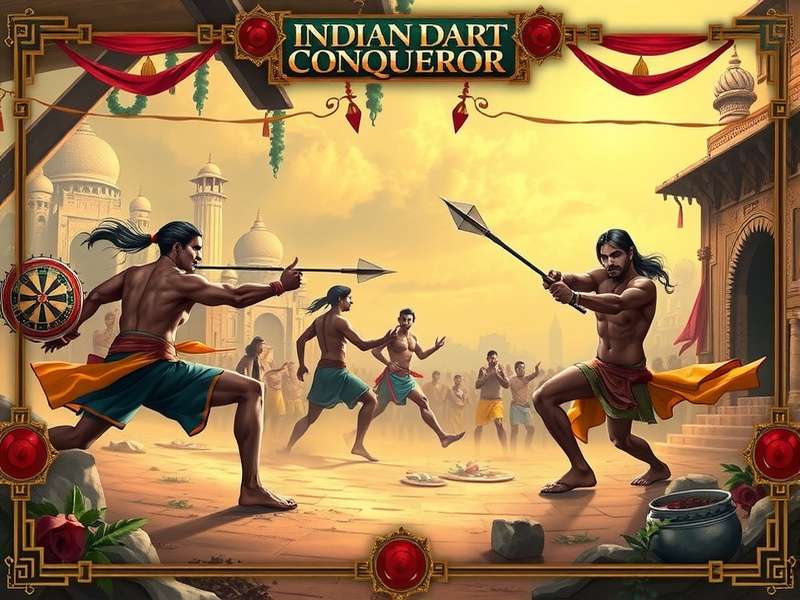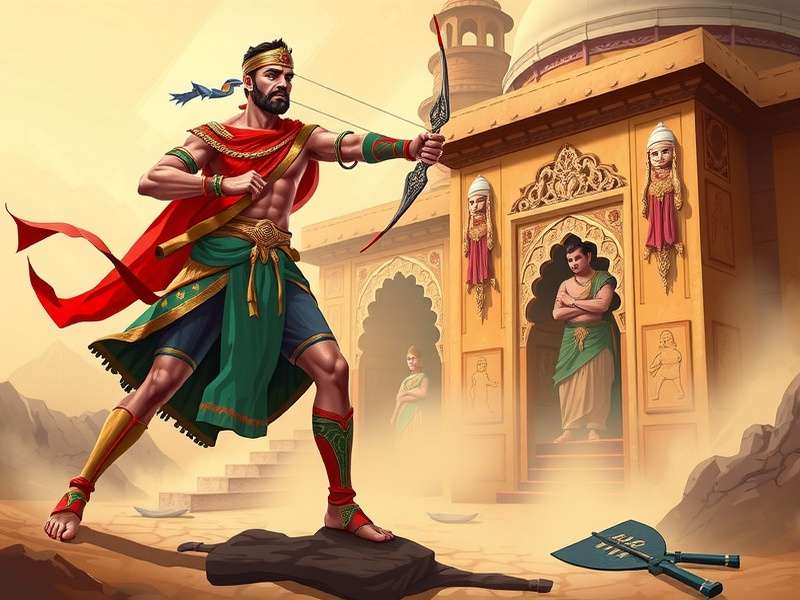Indian Dart Conqueror: The Ultimate Encyclopedia 🎯
Discover the rich history, rules, and strategies of India's most beloved traditional dart game
Overview of Indian Dart Conqueror
Indian Dart Conqueroris a traditional Indian game that combines skill, strategy, and precision. This game has been played for centuries across various regions of India, with each area adding its unique flavor to the rules and gameplay.

The objective ofIndian Dart Conqueroris simple yet challenging: players throw darts at a target board divided into different scoring zones, aiming to accumulate points and ultimately "conquer" their opponents by achieving the highest score or specific target numbers.
🎯 Quick Facts
- Origin:Ancient India, with regional variations
- Players:2 or more individuals or teams
- Equipment:Traditional darts and target board
- Skill Level:Beginner to expert
- Game Duration:15-45 minutes per round
What setsIndian Dart Conquerorapart from Western dart games is its unique scoring system, the incorporation of strategic elements reminiscent of traditional Indian board games, and the cultural significance attached to various aspects of gameplay.
The game has seen a resurgence in popularity in recent years, with tournaments being organized at local, regional, and national levels. This revival has introducedIndian Dart Conquerorto a new generation of players while preserving its traditional roots.
Historical Background 📜
The origins ofIndian Dart Conquerorcan be traced back to ancient India, where it was initially played as a training exercise for warriors. Historical texts and archaeological findings suggest that variations of dart games were prevalent in different kingdoms across the Indian subcontinent.
During the Mughal era, the game evolved significantly, incorporating elements of precision and strategy that reflected the military tactics of the time. The Mughal nobility often played elaborate versions of dart games during festivals and celebrations.
🕰️ Historical Timeline
200 BCE - 300 CE:Earliest evidence of dart-like games in ancient Indian texts
1200 - 1500 CE:Development of regional variations across different kingdoms
1600 - 1800 CE:Standardization of rules during Mughal and Maratha periods
1900s:Decline during British colonial rule, preservation in rural areas
2000s:Revival and modernization with organized tournaments
In rural India,Indian Dart Conquerorremained a popular pastime, often played during festivals, weddings, and community gatherings. Different regions developed their variations, with unique rules, scoring systems, and even dart designs.
The post-independence period saw efforts to document and standardize the game, leading to the establishment of formal rules in the 1970s. This standardization helped preserve the traditional aspects ofIndian Dart Conquerorwhile making it accessible to a wider audience.

Today,Indian Dart Conquerorstands as a testament to India's rich cultural heritage, blending ancient traditions with modern competitive spirit. Organizations dedicated to preserving traditional Indian sports have played a crucial role in its recent resurgence.
Game Rules & Regulations 📋
Understanding the rules ofIndian Dart Conqueroris essential for both beginners and experienced players. The game follows a structured set of regulations that ensure fair play while maintaining the strategic depth that makes it so engaging.
Basic Setup
The game requires a standard dartboard placed at a regulation height of 5 feet 8 inches from the floor to the center of the bullseye. The throwing line is typically 7 feet 9.25 inches from the face of the board, though regional variations may exist.
🎯 Scoring System
The dartboard inIndian Dart Conqueroris divided into 20 numbered sections, with points ranging from 1 to 20. The bullseye consists of two parts: the outer bull (25 points) and the inner bull (50 points).
Unlike Western darts,Indian Dart Conquerorincorporates special scoring zones that multiply points based on strategic positioning and consecutive hits.
🔄 Gameplay Flow
Players take turns throwing three darts each. The starting player is determined by a preliminary round where each player throws one dart, with the closest to the bullseye going first.
Each round consists of players alternating throws, with scores recorded after each turn. The game typically continues until a player reaches a predetermined score, usually 301, 501, or 1001, depending on the variation being played.
🏆 Winning Conditions
To win a game ofIndian Dart Conqueror, a player must reach exactly zero points, with the final dart landing in a double segment or the bullseye. This finishing requirement adds a strategic layer to the endgame.
If a player scores more than the required points to reach zero, that round's score is invalidated, and their turn ends without reducing their total.
Advanced Rules
For experienced players,Indian Dart Conqueroroffers several advanced variations that increase the strategic complexity. These include "Killer" mode, where players target specific opponents' scoring zones, and "Round the Clock," which requires hitting numbers in sequence.

Tournament play often incorporates additional regulations regarding equipment specifications, time limits between throws, and conduct guidelines to maintain the spirit of sportsmanship that has always been central toIndian Dart Conqueror.
Winning Strategies & Techniques 🧠
MasteringIndian Dart Conquerorrequires more than just accurate throwing; it demands strategic thinking, mental focus, and an understanding of probability. Successful players develop a comprehensive approach that combines technical skill with game theory.
Fundamental Techniques
The foundation of success inIndian Dart Conquerorbegins with proper stance, grip, and throwing motion. Players should maintain a consistent posture, with their dominant foot slightly forward and body weight distributed evenly.
🎯 Precision Training Tips
- Practice consistent grip pressure - not too tight, not too loose
- Develop a smooth, repeatable throwing motion
- Focus on follow-through, keeping your arm extended toward the target
- Train regularly with specific targets to build muscle memory
- Incorporate mental visualization techniques before throwing
Strategic Gameplay
Beyond physical technique,Indian Dart Conquerorrewards players who think several moves ahead. Understanding scoring probabilities and opponent tendencies can provide significant advantages during competitive play.
One key strategy involves "setting up" favorable finishes by leaving yourself with commonly practiced combinations. For example, aiming to leave 32 points (double 16) rather than 33 points, which requires a more difficult single 1 followed by double 16.
📊 Mathematical Approach
Advanced players ofIndian Dart Conqueroroften employ statistical analysis to optimize their targeting. By understanding the probability distribution of their throws, they can maximize expected points per round.
This mathematical approach involves prioritizing targets that offer the best risk-reward ratio based on individual skill level and current game situation.
Psychological Elements
The mental aspect ofIndian Dart Conquerorcannot be overstated. Maintaining focus, managing pressure situations, and reading opponents are crucial skills that separate elite players from casual participants.
Many champion players develop pre-throw routines to enhance concentration and create consistency in high-pressure situations. These rituals help create a mental state conducive to peak performance.
Understanding opponent tendencies and adapting your strategy accordingly is another advanced aspect ofIndian Dart Conqueror. Observing how opponents approach different game situations can reveal weaknesses to exploit.
Cultural Significance & Impact 🌍
Indian Dart Conqueroris more than just a game; it represents an important aspect of India's cultural heritage. Throughout history, the game has been intertwined with social customs, religious festivals, and community bonding.
Traditional Celebrations
In many parts of India,Indian Dart Conquerortournaments are organized during major festivals such as Diwali, Holi, and Pongal. These events serve as community gatherings that strengthen social bonds while preserving traditional gameplay.
The game often features in wedding celebrations in certain regions, where friendly competitions between families of the bride and groom add a festive atmosphere to the proceedings.
🎉 Festival Associations
Diwali:Symbolizes the victory of precision and skill, aligning with the festival of lights theme
Holi:Colorful variations of the game are played during this spring festival
Pongal:Harvest festival competitions that celebrate community and abundance
Navratri:Nine-night tournaments that mirror the festival's duration
Regional Variations
One of the most fascinating aspects ofIndian Dart Conqueroris how it has evolved differently across India's diverse regions. These variations reflect local cultures, materials available, and historical influences.
In Rajasthan, for example, the game traditionally used heavier darts and larger targets, reflecting the martial culture of the region. In contrast, coastal regions like Kerala developed lighter darts suited to their tropical climate.
The northeastern states incorporated bamboo elements into their dart designs, while Himalayan regions developed variations that could be played in colder conditions with thicker clothing.
Modern Revival & Global Reach
In recent decades, there has been a concerted effort to preserve and promoteIndian Dart Conqueroras part of India's intangible cultural heritage. Organizations dedicated to traditional sports have established standardized rules while respecting regional variations.
The digital age has introducedIndian Dart Conquerorto global audiences through mobile applications and online tournaments. This technological adaptation has helped the game reach new players while maintaining its traditional essence.
International interest inIndian Dart Conquerorhas grown steadily, with demonstration events being held at cultural festivals worldwide. This global exposure has created opportunities for cultural exchange and appreciation of India's gaming traditions.
🔮 Future Prospects
The future ofIndian Dart Conquerorlooks promising, with initiatives underway to include it in school physical education programs, establish professional leagues, and potentially seek recognition as an official sport at national and international levels.
As interest in traditional games continues to grow globally,Indian Dart Conquerorstands poised to become not just a cherished cultural artifact, but a living, evolving sport that bridges generations and cultures.